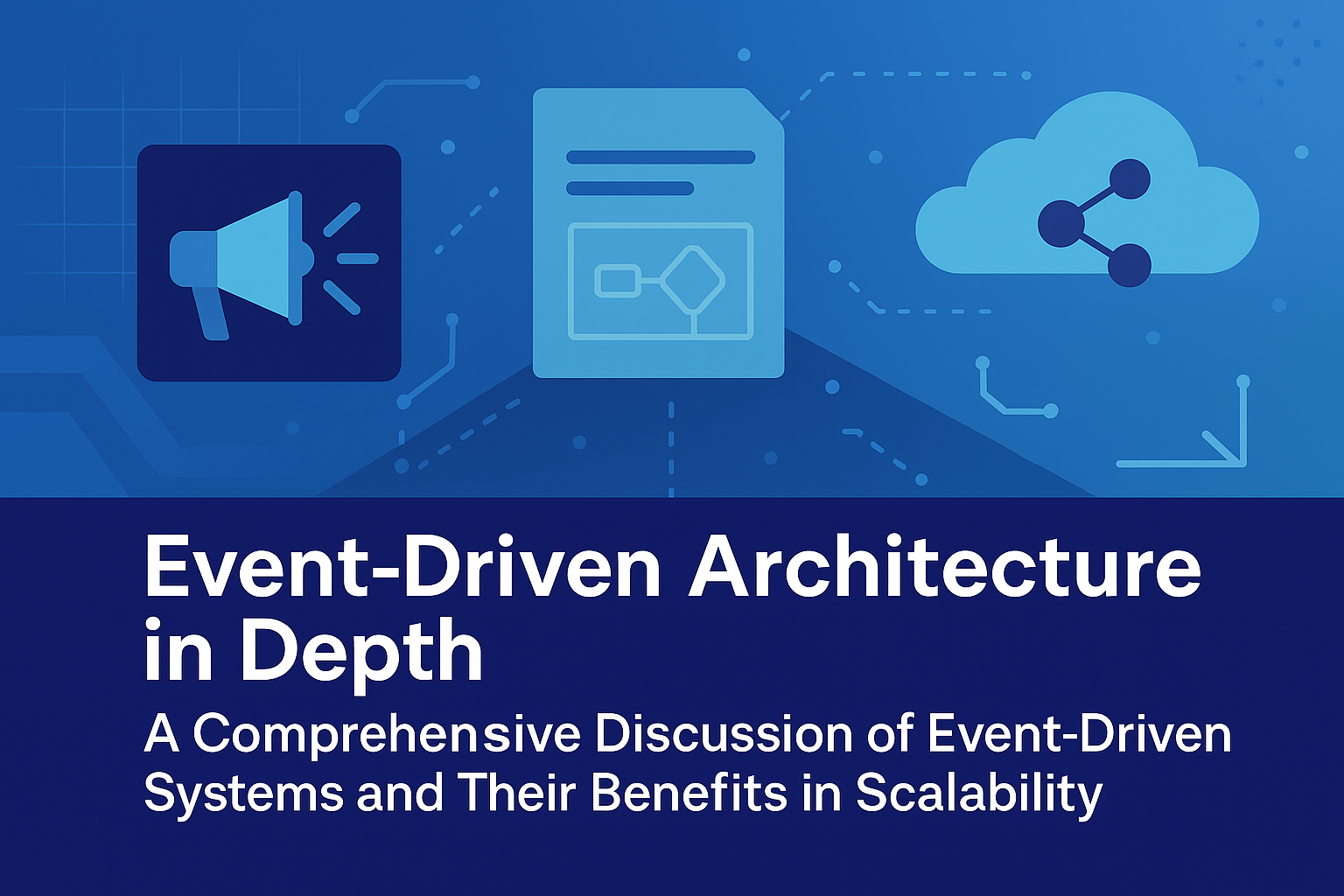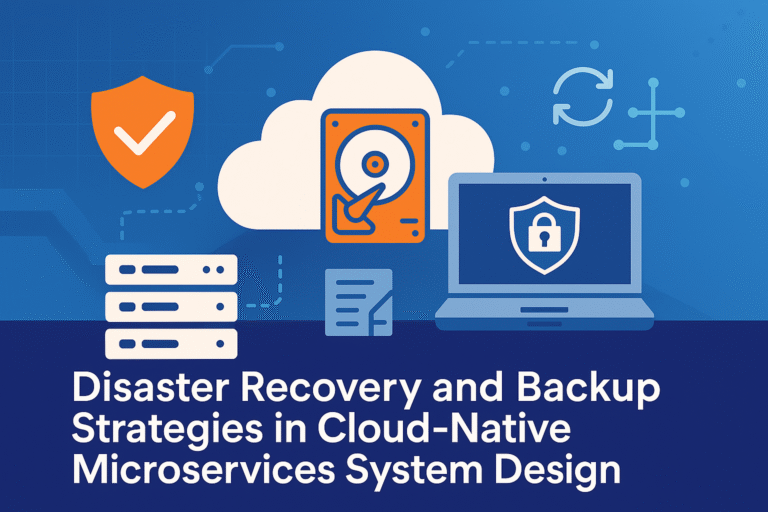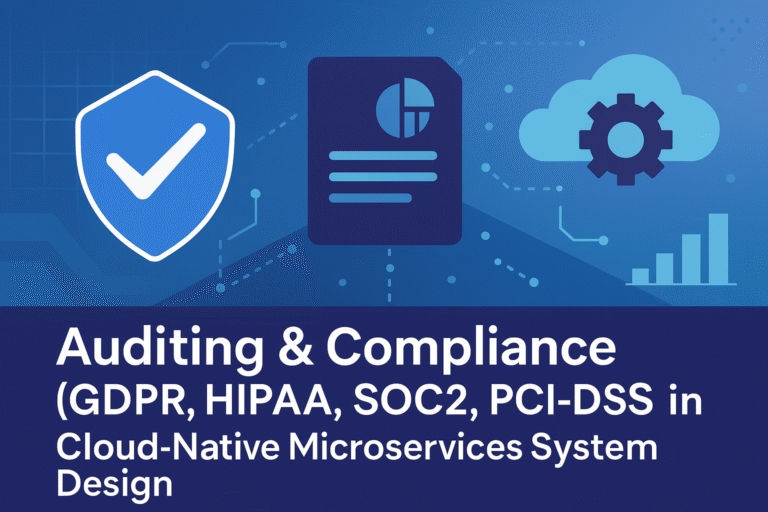Introduction
Event-Driven Architecture (EDA) is a design paradigm in distributed systems that emphasizes the production, detection, consumption, and reaction to events—discrete occurrences or changes in system state. Unlike traditional request-response models, where components interact synchronously, EDA promotes asynchronous communication through events, enabling loose coupling, high responsiveness, and efficient resource utilization. This architecture is particularly valuable in modern applications requiring real-time processing, such as financial trading platforms, IoT ecosystems, and e-commerce systems, where events like user actions or sensor readings must trigger immediate responses. EDA aligns with the CAP Theorem by favoring availability and partition tolerance (AP systems), often employing eventual consistency to achieve scalability while managing trade-offs in latency and complexity. This analysis explores EDA’s mechanisms, benefits—especially in scalability—applications, advantages, limitations, trade-offs, and strategic considerations, integrating prior concepts like message queues (e.g., Kafka), Change Data Capture (CDC), quorum consensus, multi-region deployments, and capacity planning to provide a structured framework for system design professionals.
Mechanisms of Event-Driven Architecture
Core Components
EDA revolves around events as the primary unit of communication. An event is a self-contained message representing a change or occurrence, typically including metadata such as timestamp, source identifier, and payload.
- Event Producers: Components that detect changes and generate events (e.g., a database trigger via CDC publishing an update to a Kafka topic).
- Event Bus or Broker: A centralized or distributed messaging system (e.g., Kafka, RabbitMQ) that routes events to subscribers. It handles buffering, partitioning (via consistent hashing), and replication for durability.
- Event Consumers: Components that subscribe to events and react accordingly (e.g., a microservice processing a payment event to update inventory).
- Event Processing: Involves filtering, aggregation, or transformation, often using stream processors like Kafka Streams or Apache Flink for real-time handling.
Workflow
- Event Generation: Producers emit events asynchronously (e.g., using idempotency to ensure safe retries without duplicates).
- Event Routing: The broker distributes events based on topics or keys, employing load balancing (e.g., Least Connections) and rate limiting (e.g., Token Bucket) to manage flow.
- Event Consumption: Consumers pull or receive events, processing them with failure handling mechanisms (e.g., retries with exponential backoff, dead-letter queues for unprocessable events).
- State Management: For stateful processing, use external stores (e.g., Redis for caching processed states) or built-in state (e.g., Flink’s checkpointing).
- Monitoring and Liveness: Heartbeats (e.g., 1s interval) ensure consumer liveness, with quorum consensus (e.g., in KRaft) for broker coordination.
- Mathematical Foundation:
- Scalability: Throughput = N×P×Tp N \times P \times T_p N×P×Tp, where N N N is nodes, P P P is partitions, and Tp T_p Tp is throughput per partition (e.g., 10 nodes × 50 partitions × 2,000 events/s = 1M events/s).
- Latency: End-to-end latency = produce_time + routing_delay + consume_time (e.g., < 10ms in Kafka with local brokers).
- Event Lag: Lag = backlog / consume_rate (e.g., 1,000 events / 10,000 events/s = 0.1s).
EDA’s asynchronous nature decouples components, allowing independent scaling and failure isolation, while integrating with CDC for database event capture and GeoHashing for location-based routing.
Benefits of Event-Driven Architecture
Scalability Benefits
EDA inherently supports scalability by decoupling producers from consumers, enabling independent horizontal scaling.
- Horizontal Scalability: Add nodes or partitions to handle increased load without redesigning the system. For example, in Kafka, adding brokers increases capacity linearly (e.g., from 500,000 to 1M events/s by doubling brokers).
- Elasticity: Dynamically scale consumers based on event volume (e.g., auto-scaling in Kubernetes for Flink jobs), aligning with capacity planning forecasts.
- Load Distribution: Consistent hashing in brokers (e.g., Kafka partitions) ensures even event distribution (< 5% variance), while load balancing (e.g., Least Connections) optimizes consumer workloads.
- Global Scalability: Multi-region deployments replicate events across regions (e.g., Kafka cross-region mirroring), reducing latency (< 50ms for local consumers) while maintaining availability (99.999%).
- Resource Efficiency: Asynchronous processing avoids blocking, maximizing throughput (e.g., 1M events/s) and minimizing idle resources.
Other benefits include:
- High Availability: Event brokers (e.g., Kafka with 3 replicas) tolerate failures, ensuring 99.999% uptime via heartbeats and leader election.
- Fault Tolerance: Idempotency and checksums (e.g., SHA-256) ensure safe retries and data integrity during failures.
- Flexibility: Supports diverse workloads, from real-time alerts to batch analytics.
Performance Metrics
- Throughput: 1M+ events/s in large clusters (e.g., 10 brokers with 50 partitions).
- Latency: < 10ms end-to-end for local processing, 50–100ms in multi-region.
- Availability: 99.999% with replication and failover (< 5s via leader election).
- Scalability Limit: Virtually unlimited with added resources, constrained by network (e.g., 10 Gbps bandwidth limits ~10M events/s at 1KB/event).
- Lag: < 100ms under normal load, monitored to prevent backlogs.
Applications and Real-World Examples
1. Real-Time Fraud Detection in Financial Services
- Context: A bank processes 500,000 transactions/day, needing immediate fraud alerts to minimize losses.
- Implementation: Transactions are published as events to a Kafka topic (e.g., “transactions”) with 20 partitions for scalability. Flink consumers process events in real time, aggregating patterns (e.g., unusual locations via GeoHashing) and triggering alerts if thresholds are exceeded. Idempotency ensures duplicate events (from retries) are ignored, while rate limiting caps suspicious traffic. Multi-region deployment replicates events for global access, with quorum consensus (KRaft) for metadata consistency. Heartbeats monitor consumer health, and failure handling reroutes to healthy nodes.
- Performance: < 10ms event latency, 500,000 events/s, 99.999% uptime.
- Strategic Value: Scalability handles peak trading hours (2x normal load), eventual consistency suffices for alerts (10–100ms lag acceptable).
- Trade-Off: Higher complexity in stream processing balanced by reduced fraud losses (e.g., 50% detection improvement).
2. IoT Sensor Data Processing in Manufacturing
- Context: A factory monitors 1M sensor readings/s from equipment, needing real-time anomaly detection to prevent downtime.
- Implementation: Sensors produce events to a “sensor_data” topic with 50 partitions, using consistent hashing for distribution. Kafka Streams aggregates readings (e.g., average temperature over 1-minute windows), incorporating GeoHashing for location-specific alerts (e.g., machine overheating). CDC from equipment databases feeds historical data, with checksums (SHA-256) ensuring integrity. Rate limiting prevents sensor floods, and multi-region replication supports global factories. Quorum consensus manages partition leaders, heartbeats detect broker failures (< 5s failover), and idempotency handles duplicate readings.
- Performance: < 10ms latency, 1M readings/s, 99.999% uptime.
- Strategic Value: Scalability accommodates new sensors without redesign, eventual consistency allows minor lag for non-critical alerts.
- Trade-Off: Continuous processing increases compute costs ($0.05/GB/month) but reduces downtime by 40%.
3. Customer Analytics Pipeline in Retail
- Context: A retail chain analyzes 100,000 customer interactions/day from CRM and sales systems to personalize marketing.
- Implementation: Source connectors (Kafka Connect) ingest data from Salesforce (CRM) and point-of-sale systems into “customer_events” topics with 10 partitions. Streams transform data (e.g., enrich with purchase history), and sink connectors deliver to BigQuery for querying. CDC captures database changes, unique IDs (Snowflake) ensure idempotency, and rate limiting controls ingress. Multi-region deployment replicates pipelines, quorum consensus handles metadata, and heartbeats ensure connector liveness.
- Performance: < 100ms latency, 100,000 events/s, 99.999% uptime.
- Strategic Value: Scalability supports growth (20% monthly), eventual consistency acceptable for non-real-time analytics.
- Trade-Off: Pipeline complexity (10–15% overhead) balanced by automated insights.
4. Logistics Supply Chain Monitoring
- Context: A logistics firm tracks 500,000 shipments/day, needing real-time visibility for delays or rerouting.
- Implementation: Shipment events (e.g., location updates) are published to “shipment_events” topics with 30 partitions. Streams process events (e.g., detect delays using GeoHashing for proximity), triggering alerts via sink connectors to a notification system. CDC from warehouse databases feeds inventory data, checksums verify event integrity, and rate limiting prevents overload. Multi-region replication ensures global tracking, with quorum consensus for partition management.
- Performance: < 50ms latency, 500,000 events/s, 99.999% uptime.
- Strategic Value: Scalability handles peak seasons (2x volume), eventual consistency suffices for monitoring (10–100ms lag).
- Trade-Off: Storage costs for retention (7 days) balanced by reduced operational delays.
Integration with Prior Concepts
- CAP Theorem: Event streaming favors AP for availability during partitions (e.g., Kafka replication).
- Consistency Models: Eventual consistency for most streams (10–100ms lag), strong for transactions.
- Consistent Hashing: Distributes events across partitions.
- Idempotency: Ensures safe event processing with unique IDs.
- Heartbeats: Monitors broker/consumer liveness.
- Failure Handling: Retries and DLQs for event failures.
- SPOFs: Replication avoids SPOFs.
- Checksums: SHA-256 for event integrity.
- GeoHashing: Enhances location-based streaming (e.g., logistics tracking).
- Load Balancing: Least Connections for consumers.
- Rate Limiting: Token Bucket caps event rates.
- CDC: Feeds pipelines from databases.
- Multi-Region: Replication for global pipelines.
- Capacity Planning: Estimates brokers (10 for 1M events/s).
Advanced Implementation Considerations
- Deployment: Use Kubernetes for Kafka with 10 brokers, 3 replicas, and SSDs for low-latency I/O.
- Configuration:
- Topics: 100–1,000 per cluster, 10–50 partitions per topic.
- Replication Factor: 3 for durability.
- Retention: 7 days for replayability.
- Performance Optimization:
- Use SSDs for < 1ms disk latency.
- Enable GZIP compression to reduce network usage by 50–70%.
- Cache consumer offsets in Redis for < 0.5ms access.
- Monitoring:
- Track throughput (1M events/s), latency (< 10ms), and lag (< 100ms) with Prometheus/Grafana.
- Monitor disk usage (> 80% triggers alerts) via CloudWatch.
- Security:
- Encrypt messages with TLS 1.3.
- Use IAM/RBAC for access control.
- Verify integrity with SHA-256 checksums (< 1ms overhead).
- Testing:
- Stress-test with JMeter for 1M events/s.
- Validate failover (< 5s) with Chaos Monkey.
- Test lag and recovery scenarios.
Discussing in System Design Interviews
- Clarify Requirements:
- Ask: “What’s the data volume (1M events/s)? Latency needs (< 10ms)? Real-time or periodic processing?”
- Example: Confirm real-time fraud detection for banking with < 10ms latency.
- Propose Paradigm:
- Event Streaming: “Use for banking fraud with Kafka Streams.”
- Data Pipelines: “Use for retail analytics with Connect.”
- Example: “For manufacturing, implement event streaming for sensor monitoring.”
- Address Trade-Offs:
- Explain: “Event streaming offers low latency but requires steady resources; data pipelines are flexible but add integration overhead.”
- Example: “Use streaming for fraud, pipelines for CRM integration.”
- Optimize and Monitor:
- Propose: “Use partitioning for throughput, monitor lag with Prometheus.”
- Example: “Track banking fraud latency for optimization.”
- Handle Edge Cases:
- Discuss: “Mitigate lag with more partitions, handle failures with DLQs.”
- Example: “For manufacturing, use DLQs for failed sensor events.”
- Iterate Based on Feedback:
- Adapt: “If real-time is critical, emphasize streaming; if integration is key, use pipelines.”
- Example: “For retail, add pipelines if analytics need more sources.”
Conclusion
Apache Kafka is a versatile platform for event streaming and data pipelines, enabling real-time processing of continuous data flows and structured integration between systems. Event streaming supports immediate insights in applications like fraud detection and IoT monitoring, while data pipelines facilitate efficient ETL in retail and logistics. With performance metrics like 1M events/s throughput and < 10ms latency, Kafka’s integration with concepts like CDC, replication, and quorum consensus ensures scalability and reliability. Real-world examples demonstrate its value in diverse scenarios, while strategic trade-offs—balancing latency, cost, and complexity—guide effective implementation. By aligning with workload needs and monitoring key metrics, architects can leverage Kafka to build robust, scalable data systems.




